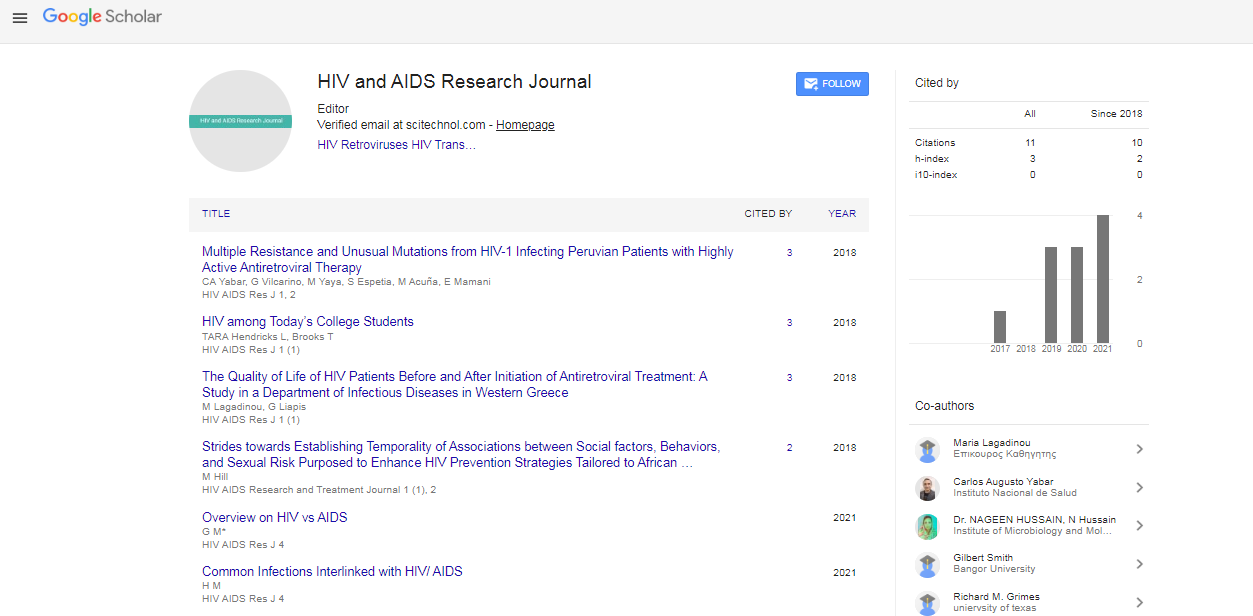Short Communication, Hiv Aids Res J Vol: 6 Issue: 1
Strategies for Combating HIV Drug Resistance
Abdur Yong*
Department of Medicine, Brown University, RI, USA
*Corresponding Author: Abdur Yong
Department of Medicine, Brown University,
RI, USA
E-mail: abduryong@bu44.edu
Received date: 20 February, 2023, Manuscript No. HARJ-23-93505;
Editor assigned date: 22 February, 2023, PreQC No. HARJ-23-93505 (PQ);
Reviewed date: 09 March, 2023, QC No. HARJ-23-93505;
Revised date: 16 March, 2023, Manuscript No. HARJ-23-93505 (R);
Published date: 23 March, 2023, DOI: 10.4172/Harj.1000115
Citation: Strategies for Combating HIV Drug Resistance. HIV AIDS Res J 6:1.
Description
Human Immunodeficiency Virus (HIV) is a virus that attacks the immune system, leading to acquired immunodeficiency syndrome. Over the years, significant progress has been made in the development of drugs to treat HIV, but drug resistance remains a significant challenge.
Antiretroviral Therapy (ART) is the current standard care for people living with HIV. ART consists of a combination of drugs that target different stages of the virus's life cycle. Antiretroviral Therapy (ART) is the cornerstone of HIV treatment [1,2]. ART is a combination of drugs that work together to lower the amount of virus in the body, called the viral load. By lowering the viral load, ART helps the immune system to recover and reduces the risk of HIV-related illnesses. The drugs used in ART are classified into six different types [3]. Nucleoside/Nucleotide Reverse Transcriptase Inhibitors (NRTIs) block the reverse transcriptase enzyme that the HIV virus uses to replicate itself. Examples of NRTIs include tenofovir, abacavir, and zidovudine. Non-Nucleoside Reverse Transcriptase Inhibitors (NNRTIs) is bind to and alter the reverse transcriptase enzyme, preventing the virus from replicating [4,5]. Examples of NNRTIs include efavirenz, nevirapine, and etravirine. Protease Inhibitors (PIs) block the protease enzyme that HIV uses to produce new copies of the virus. Examples of PIs include darunavir, atazanavir, and ritonavir. Fusion inhibitors block the virus from entering healthy cells by interfering with the fusion of the virus and the host cell. Examples of fusion inhibitors include enfuvirtide and ibalizumab. Integrase Inhibitors (INSTIs) block the integrase enzyme that HIV uses to insert its genetic material into the DNA of healthy cells [6,7]. Examples of INSTIs include raltegravir, dolutegravir, and elvitegravir. Chemokine Receptor Antagonists (CCR5) block the CCR5 protein that the virus uses to enter and infect healthy cells [8]. Examples of CCR5 antagonists include maraviroc.
Tenofovir Alafenamide (TAF) is a prodrug of tenofovir that has been shown to be more effective and safer than the older Tenofovir Disoproxil Fumarate (TDF) drug. TAF has been shown to have fewer renal and bone toxicity side effects. Dolutegravir (DTG) is an Integrase Strand Transfer Inhibitor (INSTI) that has been shown to be highly effective in treating HIV [9]. DTG is a potent drug that can suppress the virus to undetectable levels quickly. Cabotegravir (CAB) is a long-acting injectable drug that can be administered every two months. CAB has been shown to be as effective as daily oral ART in suppressing the virus. Fostemsavir is a first-in-class HIV attachment inhibitor that targets the first step in the virus's life cycle. It has been shown to be effective in people with drug-resistant HIV.
Drug resistance is a significant challenge in the treatment of HIV. Drug resistance occurs when the virus mutates, making it resistant to the drugs used to treat it. Skipping doses or not taking the drugs at the same time every day can create an environment in which the virus can mutate and become resistant to the drugs [10]. Some drugs can interact with ART, making the drugs less effective. People living with HIV should talk to their healthcare provider about any drugs they are taking, including over-the-counter drugs and herbal supplements [11]. In some cases, the virus may become resistant to the drugs even when the person is taking the drugs correctly.
Conclusion
Significant progress has been made in the development of drugs to treat HIV, and several innovative drugs have been developed in recent years. However, drug resistance remains a significant challenge, and people living with HIV must take their medication as prescribed and talk to their healthcare provider about any drugs they are taking.
References
- Rodriguez-Penney AT, Iudicello JE, Riggs PK, Doyle K, Ellis RJ et al (2013) Co-morbidities in persons infected with HIV: increased burden with older age and negative effects on health-related quality of life. AIDS Patient Care STDS 27(1):5-16.
- Mellins CA, Tassiopoulos K, Malee K, Moscicki AB, Patton D et al (2011) Behavioral health risks in perinatally HIV-exposed youth: co-occurrence of sexual and drug use behavior, mental health problems, and nonadherence to antiretroviral treatment. AIDS Patient Care STDS 25(7):413-22.
- Hall HI, Song R, Rhodes P, Prejean J, An Q et al (2008) Estimation of HIV incidence in the United States. JAMA 300(5):520-9.
- Carr A, Cooper DA (2000) Adverse effects of antiretroviral therapy. Lancet 356(9239):1423-30.
- Chesney MA (2000) Factors affecting adherence to antiretroviral therapy. Clin Infect Dis 30(2):171-176. [Google Scholar][PubMed]
- De Clercq E (2004) Non‐nucleoside reverse transcriptase inhibitors (NNRTIs): past, present, and future. Chem Biodivers 1(1):44-64. [Google Scholar][PubMed]
- Zhan P, Liu X, Li Z, Pannecouque C, De Clercq E et al (2009) Design strategies of novel NNRTIs to overcome drug resistance. Curr Med Chem 16(29):3903-17.
- Cohen MS, Chen YQ, McCauley M, Gamble T, Hosseinipour MC et al (2016) Antiretroviral therapy for the prevention of HIV-1 transmission. N Engl J Med 375(9):830-9.
- Longley DB, Johnston PG (2005) Molecular mechanisms of drug resistance. J Pathol 205(2):275-92.
- Housman G, Byler S, Heerboth S, Lapinska K, Longacre M et al (2014) Drug resistance in cancer: an overview. Cancers 6(3):1769-92.
- Gold HS, Moellering Jr RC (1996) Antimicrobial-drug resistance. N Engl J Med 335(19):1445-53.
 Spanish
Spanish  Chinese
Chinese  Russian
Russian  German
German  French
French  Japanese
Japanese  Portuguese
Portuguese  Hindi
Hindi 